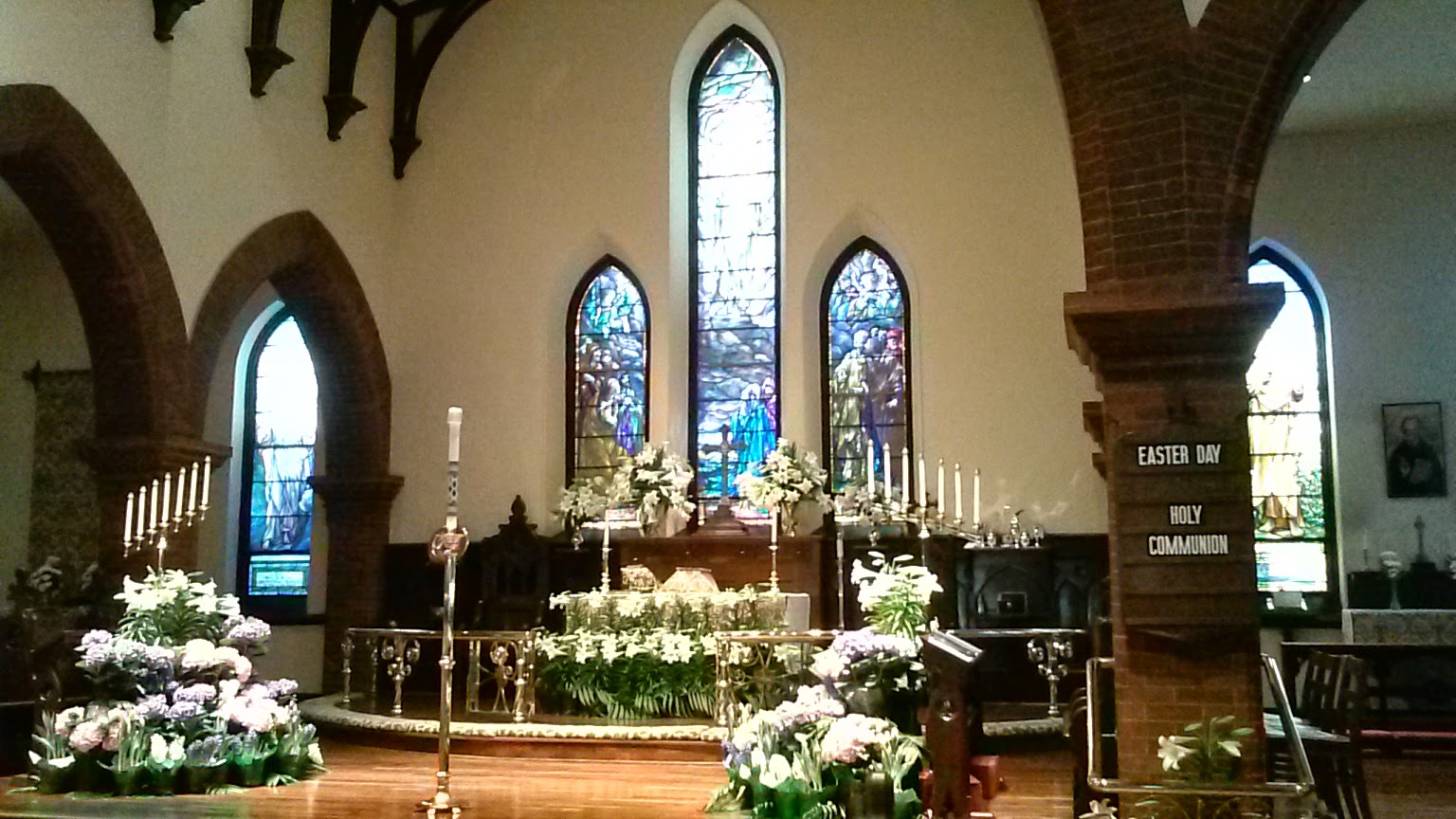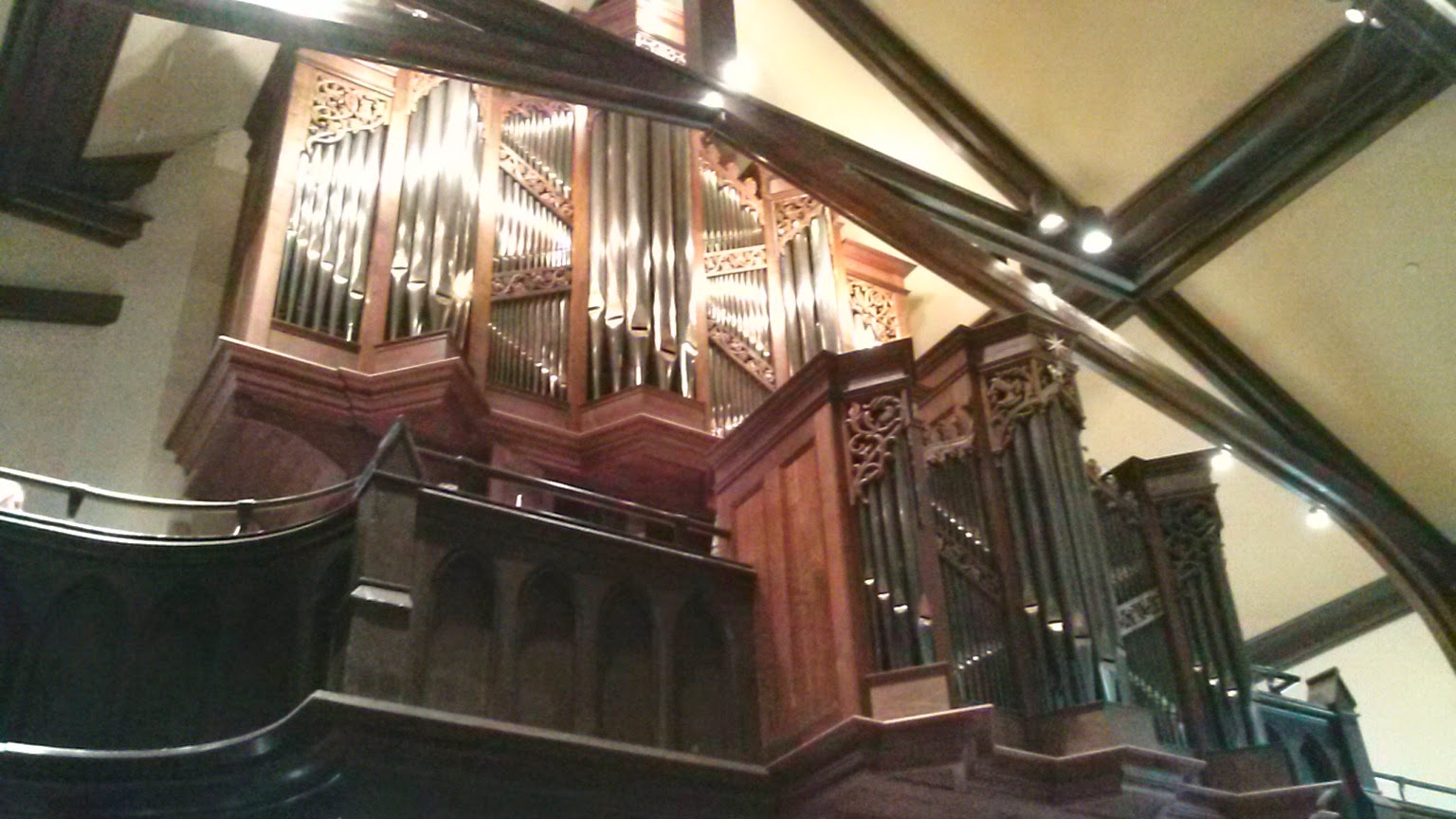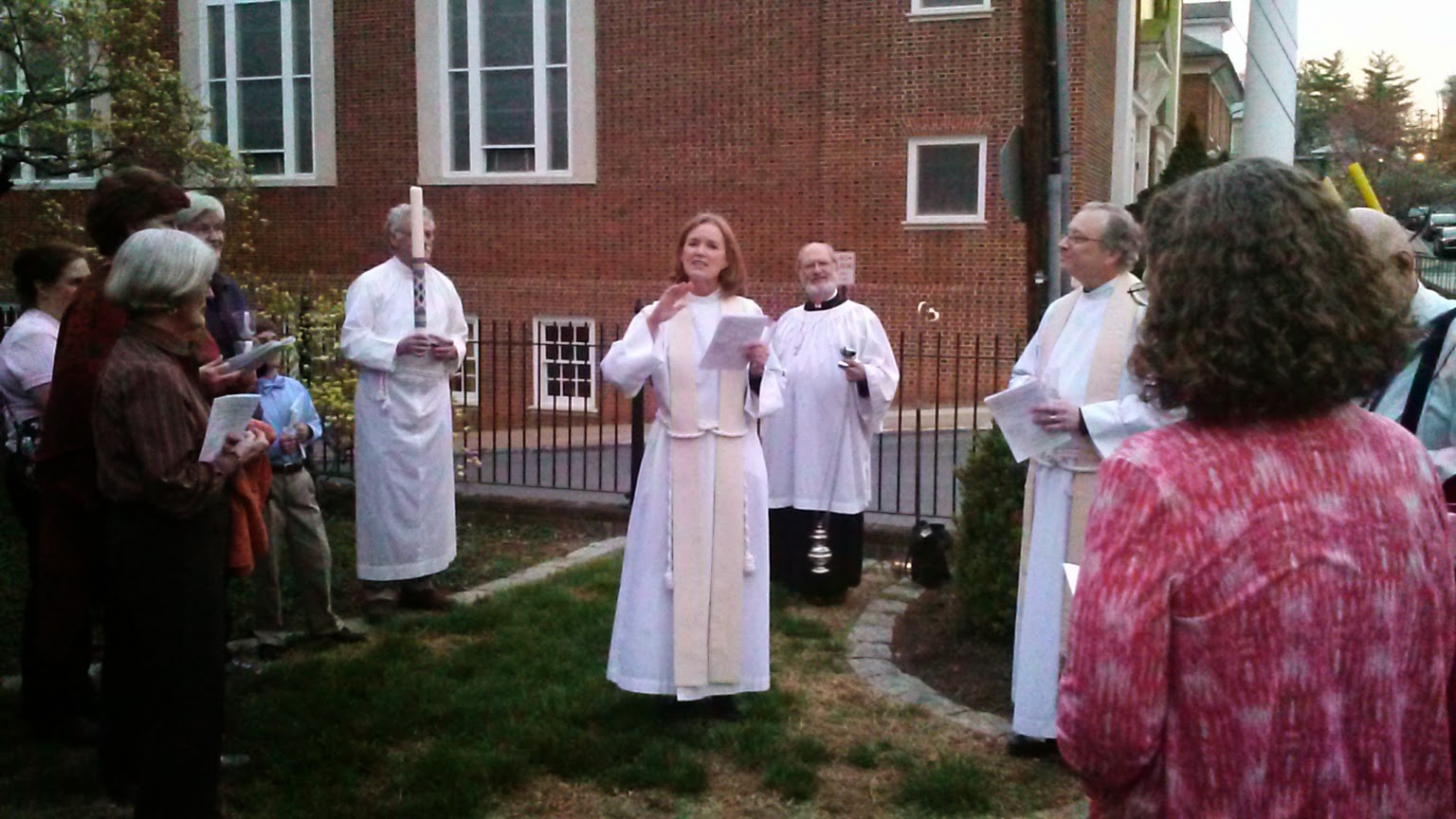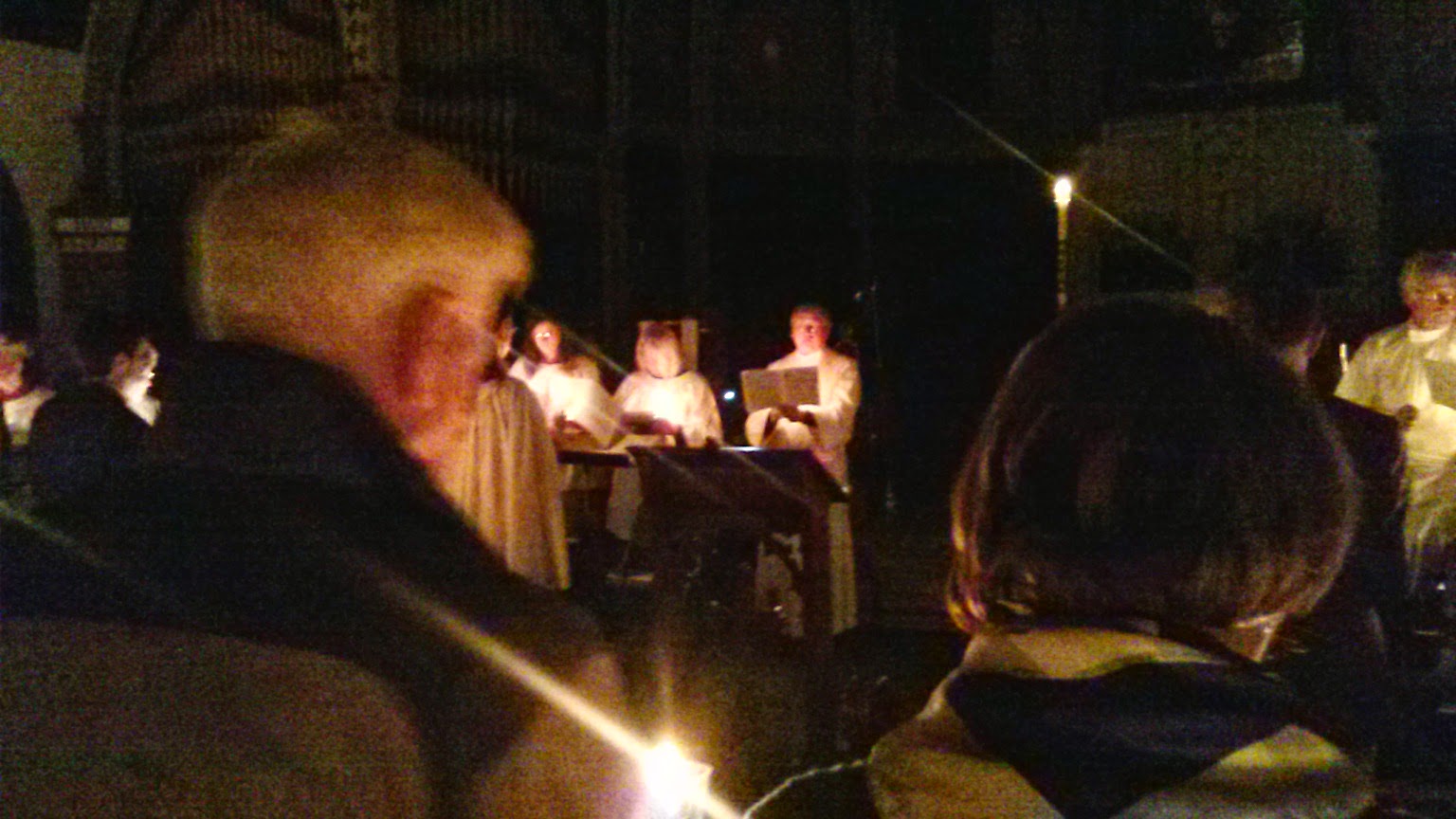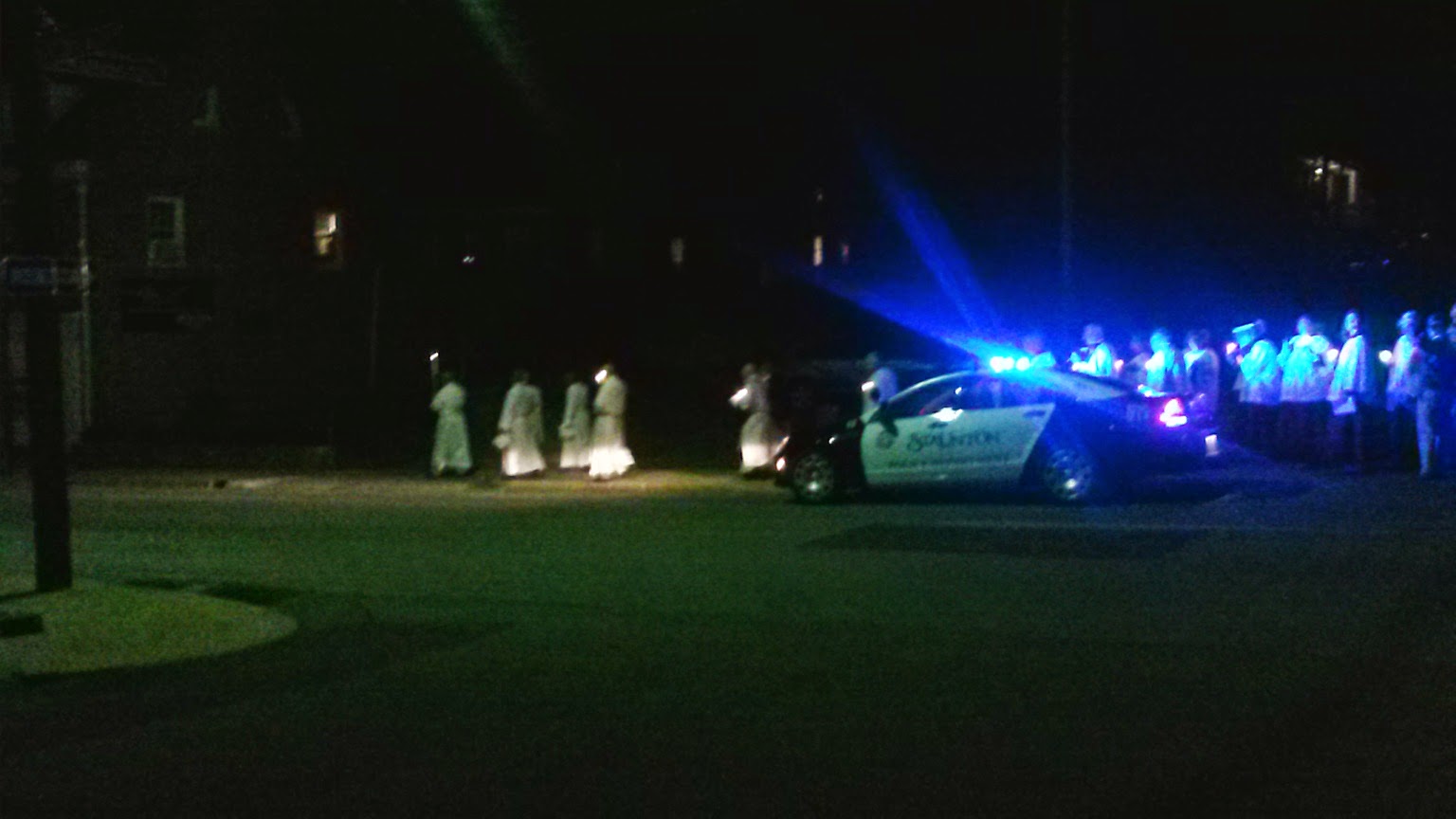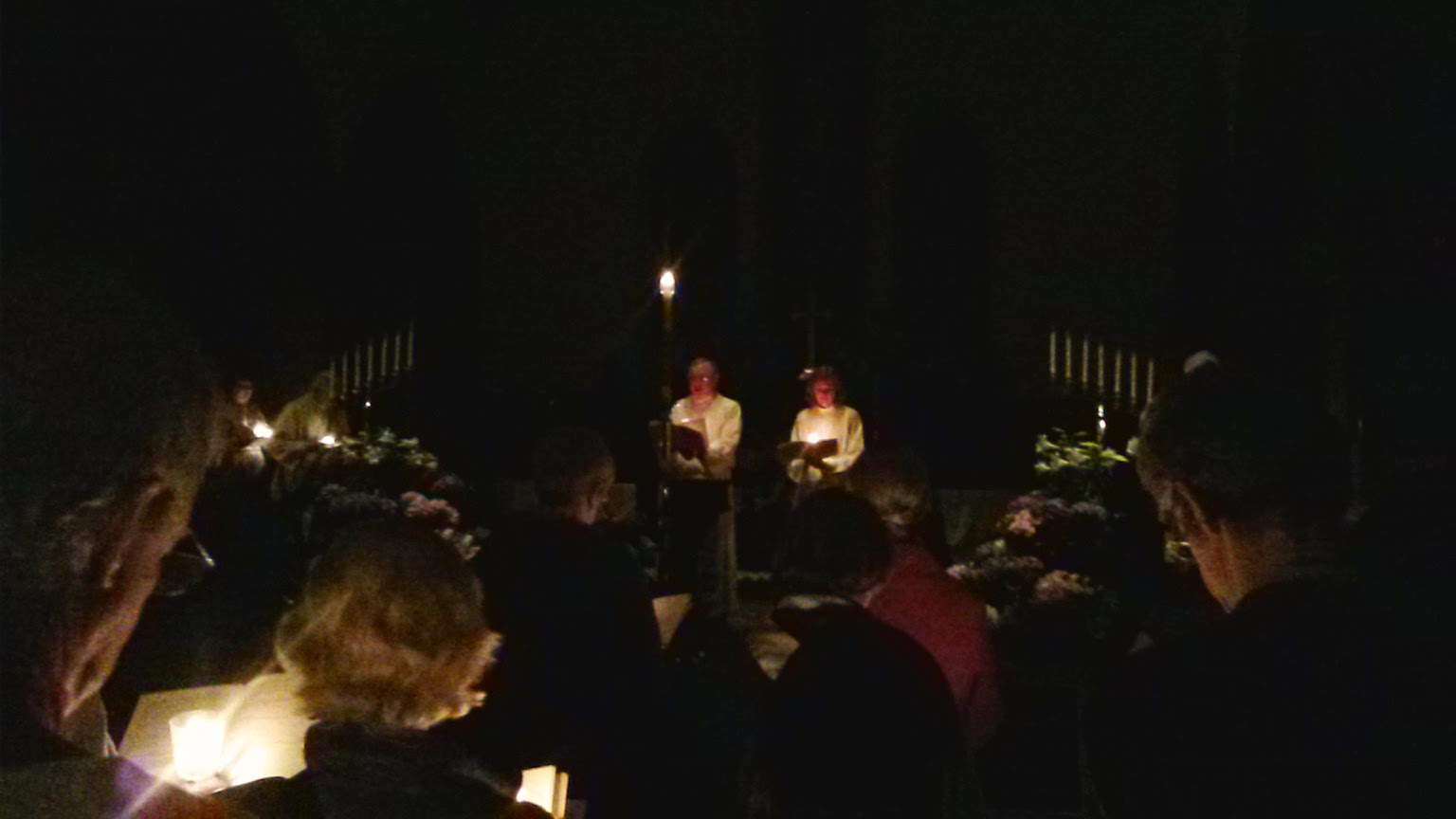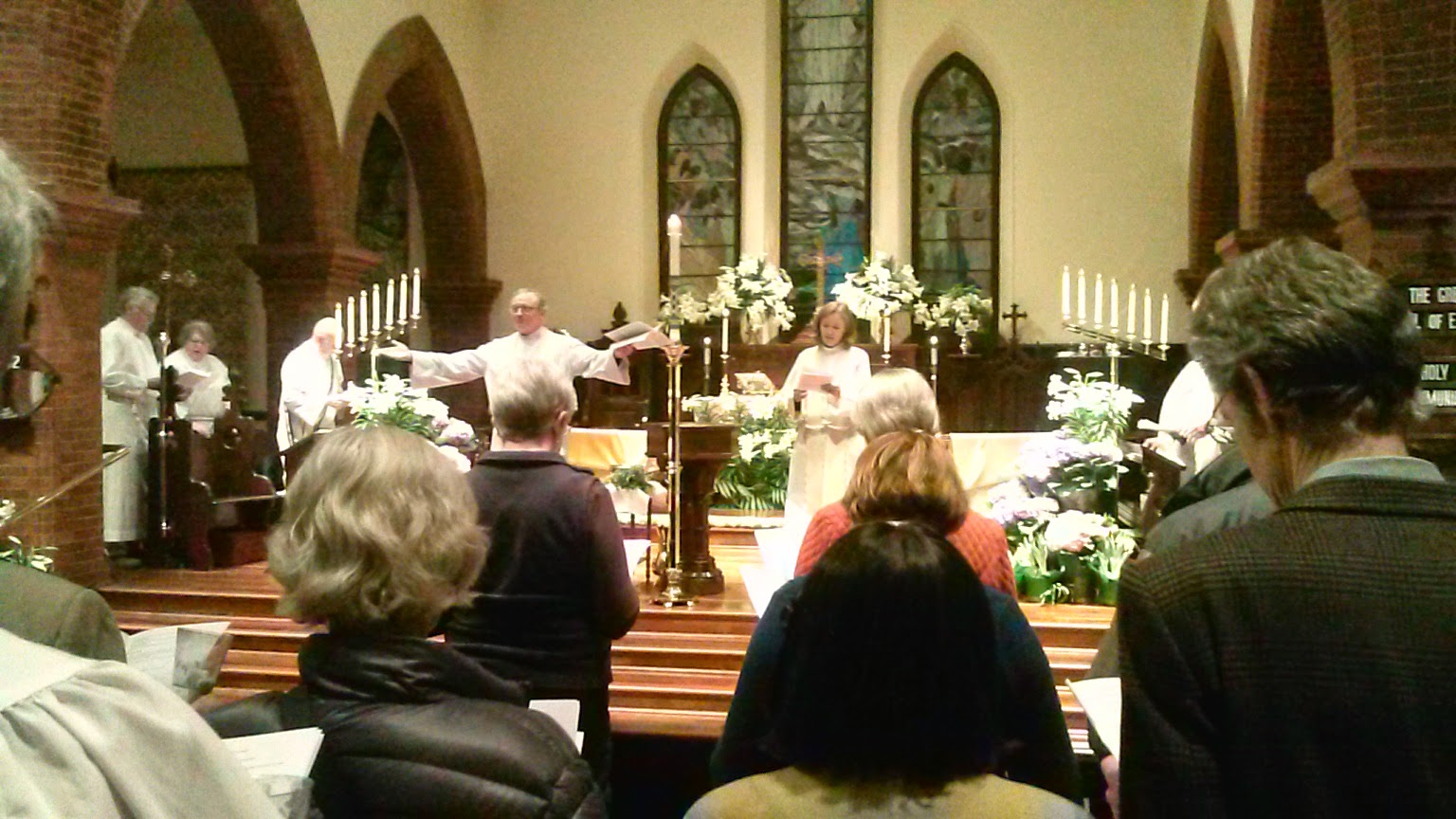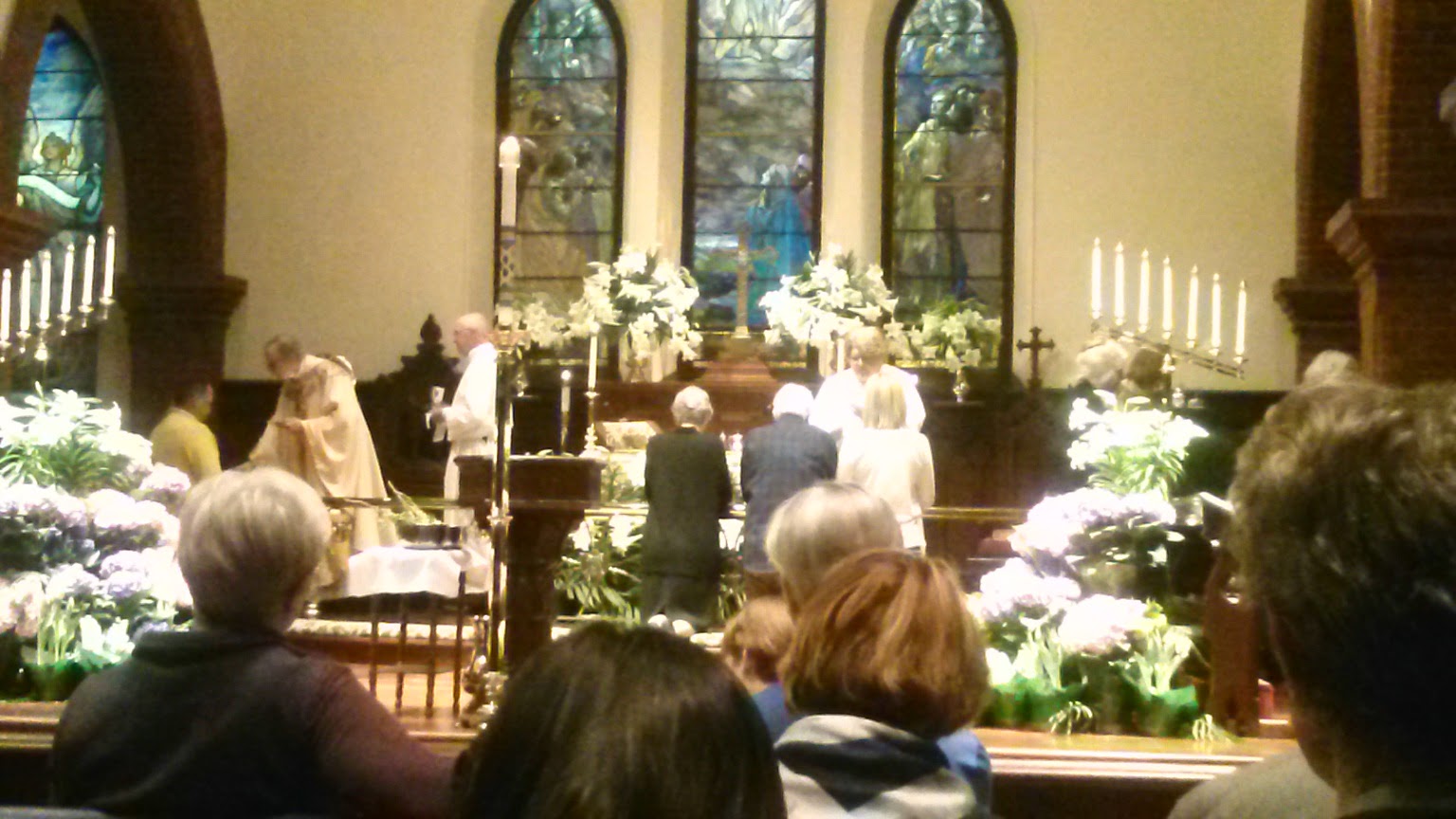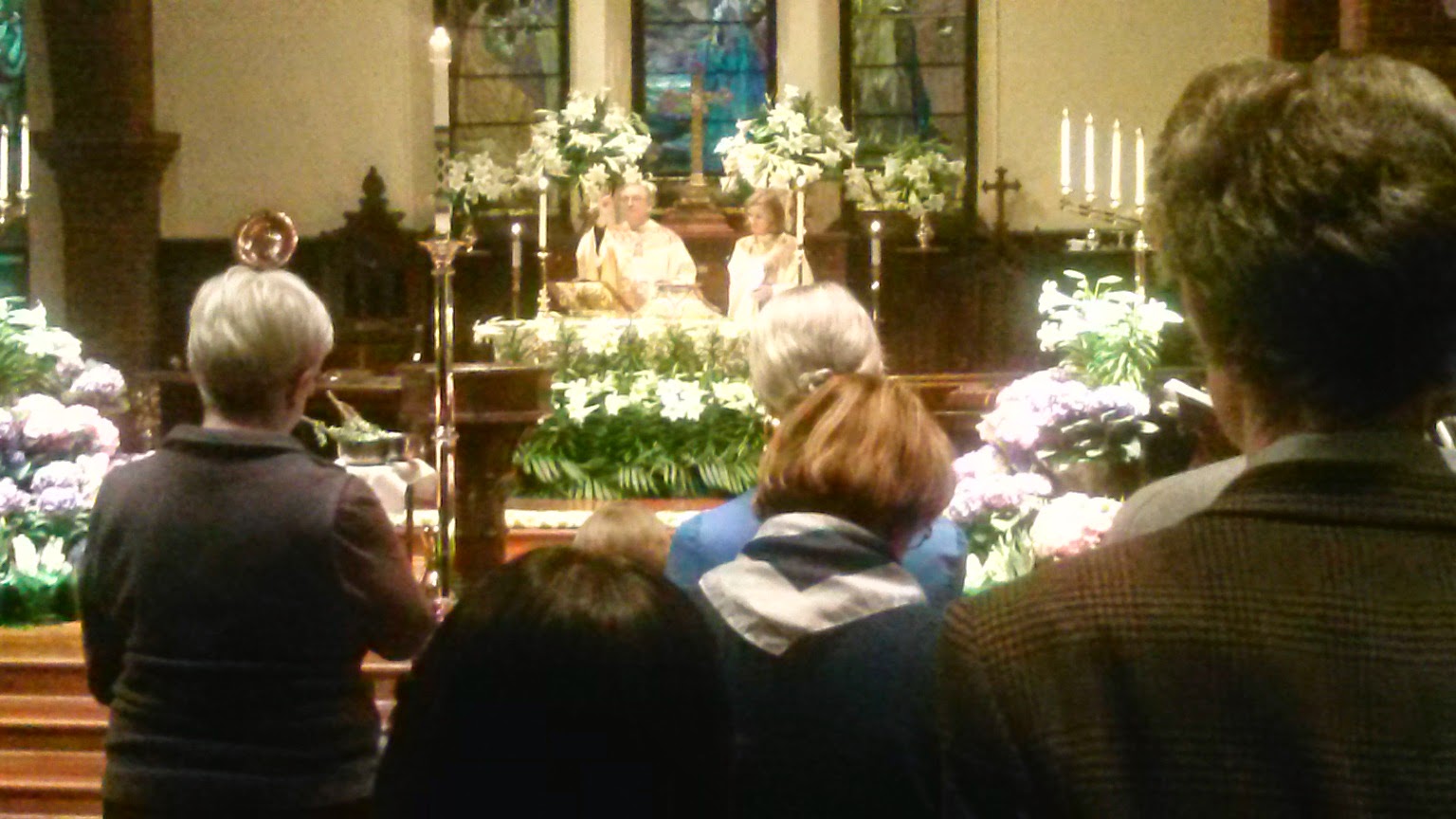Jubilate Deo! ALLELUIA! Shout with Joy to God, ALLELUIA!
The church was packed to capacity, decked out in all its glorious Easter Day splendor, the huge ornate organ bellowed out the familiar Easter strains of "Welcome, happy morning", the bells pealed, the special string ensemble added even more beauty to the majestic organ music, the combined choirs (Junior and Senior Choristers and the Trinity Choir) wafted through the sanctuary from up above where they performed in their balcony section, and the opening acclamation resounded through the sanctuary upwards into the huge wooden rafters -
ALLELUIA! Christ is risen. The Lord is risen indeed. ALLELUIA!
 |
| The Trinity Choir practices before the start of the Easter Day worship |
O God, who for our redemption gave your only-begotten Son to the death of the cross, and by his glorious resurrection delivered us from the power of our enemy: Grant us so to die daily to sin, that we may evermore live with him in the joy of his resurrection; through Jesus Christ your Son our Lord, who lives and reigns with you and the Holy Spirit, one God, now and for ever. Amen.
The Holy Gospel of our Lord Jesus Christ according to John _______
"Now on the first day of the week Mary Magdalene came to the tomb early, while it was still dark, and saw that the stone had been taken away from the tomb. So she ran and went to Simon Peter and the other disciple, the one whom Jesus loved, and said to them, 'They have taken the Lord out of the tomb, and we do not know where they have laid him.' So Peter went out with the other disciple, and they were going toward the tomb. Both of them were running together, but the other disciple outran Peter and reached the tomb first. And stooping to look in, he saw the linen cloths lying there, but he did not go in. Then Simon Peter came, following him, and went into the tomb. He saw the linen cloths lying there, and the face cloth, which had been on Jesus' head, not lying with the linen cloths but folded up in a place by itself. Then the other disciple, who had reached the tomb first, also went in, and he saw and believed; or as yet they did not understand the Scripture, that he must rise from the dead. Then the disciples went back to their homes. But Mary stood weeping outside the tomb, and as she wept she stooped to look into the tomb. And she saw two angels in white, sitting where the body of Jesus had lain, one at the head and one at the feet. They said to her, 'Woman, why are you weeping?' She said to them, They have taken away my Lord, and I do not know where they have laid him.' Having said this, she turned around and saw Jesus standing, but she did not know that it was Jesus. Jesus said to her, 'Woman, why are you weeping? Whom are you seeking?' Supposing him to be the gardener, she said to him, 'Sir, if you have carried him away, tell me where you have laid him, and I will take him away.' Jesus said to her, 'Mary.' She turned and said to him in Aramaic, 'Rabboni!' (which means Teacher). Jesus said to her, 'Do not cling to me, for I have not yet ascended to the Father; but go to my brothers and say to them, ‘I am ascending to my Father and your Father, to my God and your God.' ' Mary Magdalene went and announced to the disciples, 'I have seen the Lord'—and that he had said these things to her.
____________________________
The Easter Day Sermon - delivered by the Rev. Dr. Paul S. Nancarrow _____
 Mary turned around and saw Jesus standing there, but she did not know that it was Jesus. Jesus said to her, “Woman, why are you weeping? Whom are you looking for?”
Mary turned around and saw Jesus standing there, but she did not know that it was Jesus. Jesus said to her, “Woman, why are you weeping? Whom are you looking for?” In that moment, standing outside an empty tomb in the first light of a new morning, Mary’s entire life changed. In that moment her grief was answered, in that moment her sorrow was healed, in that moment her life became opened to a larger life.
But Mary didn’t know that yet. Jesus was risen and all life was changed, but Mary didn’t recognize him yet, Mary didn’t know it was Jesus, Mary couldn’t see who it was that was asking her not to weep.
What was it that prevented Mary from recognizing Jesus, Jesus standing there, Jesus standing there alive beyond the grave? I think the first reason Mary couldn’t see him was because she was weeping, her eyes were full of tears, and those tears literally blurred her vision, clouded what she could see, so that she couldn’t make out the face of the one talking to her. Mary’s perception was so altered by her grief that she literally could not see the Risen One who was right in front of her eyes.
But I think Mary’s inability to recognize Jesus was not just physiological: I think it was psychological as well. Mary couldn’t recognize Jesus because she knew it couldn’t possibly be Jesus talking to her. She knew Jesus was dead, she knew Jesus was gone, she knew the body had been taken – and all these things she thought she knew kept her from seeing the truth that was really there. The truth was that Jesus was risen, the truth was that the power of death had been broken, the truth was that there was more to life beyond the life she knew – but she could not recognize that truth as long as her old expectations still limited what she would allow herself to know. Mary was prevented from recognizing Jesus speaking to her because there was no place in her psyche for that new, unexpected, astonishing truth to connect.
In a moment, Mary’s entire life changed; and yet, for a moment, she did not recognize the reality the Risen One was offering her.
And I wonder how often we are like Mary in that moment. How often are we prevented from recognizing the presence of Jesus with us, how often do we not know the new life the Risen One is offering to us? How often do we let old tears, old griefs, old hurts, old expectations, alter our perceptions and get in the way of knowing the living Jesus inviting us not to weep?
Once I heard a woman speaking about the consequences of child sexual abuse she had survived in her teen years. She told us the pain and shame and anger from that abusive relationship stayed with her for years, clouding and distorting all her relationships, making it difficult for her to trust anyone who seemed to her to be in power, making it difficult for her to feel truly close, truly intimate, with anyone at all. She said that, because of that abuse, she knew, she absolutely knew she was not worthy of being loved – and that expectation about herself made it impossible for her to let herself be loved for many years. Even when the possibility for genuine love was right there in front of her, for a long time she couldn’t recognize it.
I knew a family many years ago whose newborn baby daughter was diagnosed with a cancer in her stomach. They sought the best medical treatment, and they had lots of support from their family and their church, and they prayed and they prayed for God’s healing power. But their daughter died – and in their pain and their grief they were angry at God, but their church had always taught them that everything happened according to God’s will, and God’s will was always for the best, and being angry at God for anything really was a sin. So all that anger had no place to go, and instead it turned inward. That family continued to go to church, and go through the motions of church life; but their hearts weren’t in it, it had no meaning for them, and their church connections began to get frayed, and no one from their church ever told them that it was okay to be angry with God, that the Bible is full of people who are angry with God, and that God grieved their daughter’s death with them, and God wanted nothing more than to hold their hearts in love and help them find the strength to start their lives anew. Even when the possibility for genuine life was right there in front of them, for a long time them couldn’t recognize it.
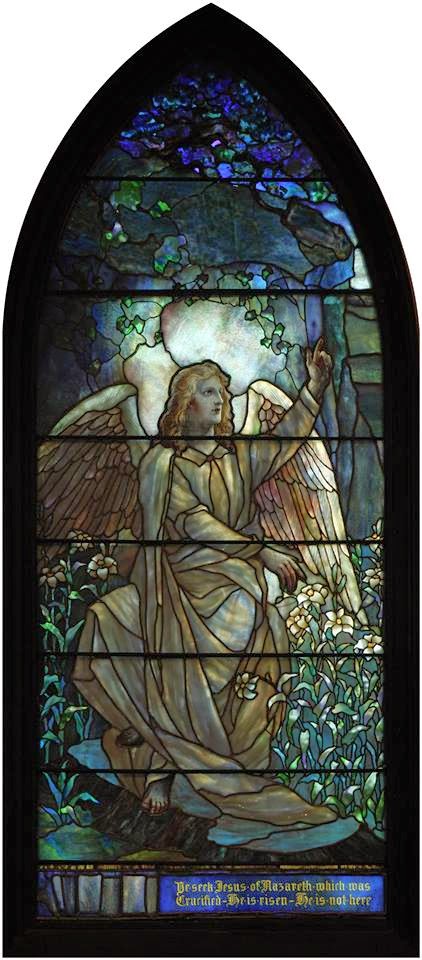 |
| The Easter Morn Achangel Gabriel is part of a pair of Easter Morn windows in Trinity. Tiffany Studios, N.Y. |
And how often are we prevented from recognizing the presence of Jesus with us? How often do we let old tears, old griefs, old hurts, old expectations, alter our perceptions and get in the way of our knowing the living Jesus inviting us not to weep?
Of course, in the story Mary is not left in that moment of unrecognition for very long. For a moment she fails to see that it is Jesus speaking to her. But then Jesus calls her by name – and in that moment of personal contact, in that moment of personal connection, in that moment of personal communion, then she knows him, then she knows that it is Jesus, then she knows that the tomb is empty not because the body has been stolen, but the tomb is empty because Jesus has broken the power of death, because Jesus has overcome the terror of the grave, because Jesus has passed through pain and suffering and sorrow and loss and has taken them up into a life that is larger than they are, a life that is so full of the love of God that nothing, nothing, not even death, can hold that life down. And recognizing Jesus as the Risen One, Mary knows that her life, too, is raised; her life, too, is caught up into a life that is larger than herself; her life, too, is brimming with new possibilities for living in the power of God’s love.
And I think we can be like Mary in that way, too. We know the reality of resurrection when it touches us in a personal way, when it engages us in a personal communion. Resurrection is just a Bible story, resurrection is just a church doctrine – until it calls us by name, until we have the experience of recognizing the living Christ present in our lives, sharing his eternal love with us.
The survivor of sexual abuse found that with great patience, and good therapy, and hard work, and the willingness to trust someone who really did love her, her life was turned around, her pain and shame no longer had power over her, she learned how to love – and that was recognizing resurrection.
The parents grieving their daughter found someone who told them it was okay to be angry with God, God was big enough to take it, and God promised no easy answers but God did promise light at the end of the tunnel, God did promise joy on the far side of grief. And bit by bit, step by step, they did their grieving work, and they rediscovered joy, and their family began to grow – and that was recognizing resurrection.
And how does that personal connection with resurrection touch you? How does the Risen One stand beside you in your life, and call you by name right now? Where in your life does grief find itself beginning to give way to joy? Where in you does fear begin to get caught up into courage? Where does confusion become decision? Where do things you already “know” open up into truths that are larger than you had imagined? Where does despair open up into hope? Where do you find yourself brimming with new possibilities for living your life in the power of God’s love? That also is recognizing resurrection.
Mary stood outside the tomb, weeping, her vision blurred by tears – until the Risen Jesus called her by name and helped her see through her tears and touched her with new life. Here, today, in this Easter celebration, Jesus calls you by name, Jesus wipes away your tears, Jesus touches you with new life. Let it be our Easter prayer that we may rejoice in this new life always. Amen. Alleluia!
Of course, in the story Mary is not left in that moment of unrecognition for very long. For a moment she fails to see that it is Jesus speaking to her. But then Jesus calls her by name – and in that moment of personal contact, in that moment of personal connection, in that moment of personal communion, then she knows him, then she knows that it is Jesus, then she knows that the tomb is empty not because the body has been stolen, but the tomb is empty because Jesus has broken the power of death, because Jesus has overcome the terror of the grave, because Jesus has passed through pain and suffering and sorrow and loss and has taken them up into a life that is larger than they are, a life that is so full of the love of God that nothing, nothing, not even death, can hold that life down. And recognizing Jesus as the Risen One, Mary knows that her life, too, is raised; her life, too, is caught up into a life that is larger than herself; her life, too, is brimming with new possibilities for living in the power of God’s love.
And I think we can be like Mary in that way, too. We know the reality of resurrection when it touches us in a personal way, when it engages us in a personal communion. Resurrection is just a Bible story, resurrection is just a church doctrine – until it calls us by name, until we have the experience of recognizing the living Christ present in our lives, sharing his eternal love with us.
The survivor of sexual abuse found that with great patience, and good therapy, and hard work, and the willingness to trust someone who really did love her, her life was turned around, her pain and shame no longer had power over her, she learned how to love – and that was recognizing resurrection.
The parents grieving their daughter found someone who told them it was okay to be angry with God, God was big enough to take it, and God promised no easy answers but God did promise light at the end of the tunnel, God did promise joy on the far side of grief. And bit by bit, step by step, they did their grieving work, and they rediscovered joy, and their family began to grow – and that was recognizing resurrection.
And how does that personal connection with resurrection touch you? How does the Risen One stand beside you in your life, and call you by name right now? Where in your life does grief find itself beginning to give way to joy? Where in you does fear begin to get caught up into courage? Where does confusion become decision? Where do things you already “know” open up into truths that are larger than you had imagined? Where does despair open up into hope? Where do you find yourself brimming with new possibilities for living your life in the power of God’s love? That also is recognizing resurrection.
Mary stood outside the tomb, weeping, her vision blurred by tears – until the Risen Jesus called her by name and helped her see through her tears and touched her with new life. Here, today, in this Easter celebration, Jesus calls you by name, Jesus wipes away your tears, Jesus touches you with new life. Let it be our Easter prayer that we may rejoice in this new life always. Amen. Alleluia!
____________________________
The service ended after all its majesty, pomp, and circumstance with one of the most anticipated organ voluntaries of the year - Charles Marie Widor's Toccata from Symphony 5.
Included below is the final two minutes of this amazing, extremely demanding and challenging piece.
